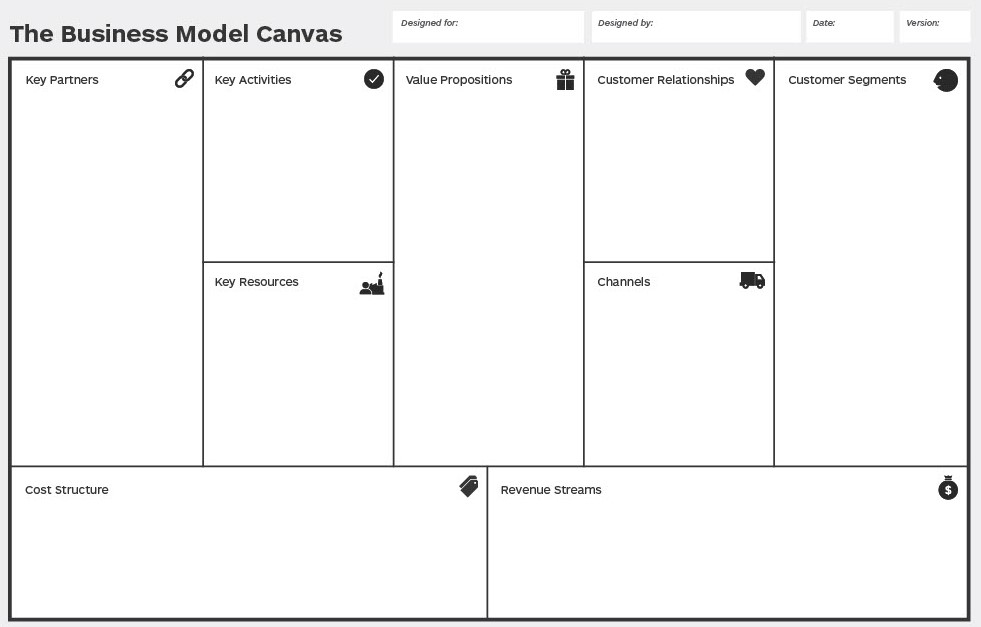Every startup founder should be able to outline their business model clearly. In this article by JTB Consulting, you will learn how to create a Business Model Canvas in our step-by-step guide.

What is the Business Model Canvas?
The business model canvas is a strategic planning tool managers and business owners use to illustrate and develop their business models. The business model canvas template clearly identifies the key elements that make up a business. Additionally, it simplifies a business plan into a condensed form. This way, the business model canvas template acts as an executive summary for the business plan.
A business model canvas is a method for determining a company’s business model in a visual, easy-to-understand way. It can be used to develop new business ideas or to sketch out the business model for an existing business. It was developed by Alexander Osterwalder in 2008 and is part of the lean startup methodology. Read more on this topic and the business model canvas template.
Every company needs to be able to clearly and concisely outline its business model. Not only does it serve as a guide for moving the company forward, but it also helps when approaching investors and partners. However, figuring out a business model can be tricky, especially for first-time founders. And that’s where the business model canvas comes in.
The business model canvas can be printed on a large scale so that an entire team can work on it together. Consider using post-it notes so that ideas can be added, subtracted, and moved around as you work collaboratively toward developing a clear business model for your startup.

The Business Model Canvas Explained ― Business Model Canvas Framework.
The business model canvas framework contains nine sections. Let’s take a closer look at each one.
Key Partners ― For the key partners’ section, you’re trying to determine who else you need for your startup to be successful. Who’s going along for this ride with you and your team?
Ask:
- Who are our key partners?
- Who are your suppliers, if relevant?
- Who are your investors, if relevant?
Key Activities ― What’s the most important thing your company has to do to be successful? The answer to this is often the product or service you deliver to the end customer.
Ask:
- What’s the most important action your startup needs to take to be successful? You must settle on one.
Key Resources ― To be successful, your startup needs various resources. “Resources” doesn’t just mean money, though, although that type of resource is certainly important. Resources refer to everything your startup needs to succeed.
Ask:
- What financial resources do we need?
- What human resources do we need?
- What physical resources do we need?
- What intellectual resources do we need?
Value Proposition ― Your startup’s value proposition is your promise to customers about the services or goods you will deliver. It can also be considered the value your customers find in your product.
Ask:
- What value do we bring to our customers?
- What problem are we solving?
- What makes us different from our competitors?
- What’s new about our startup?
Customer Segments ― No product can survive without customers, making it essential to determine your customer segments. The business model canvas has five customer segments: mass market, niche market, segmented, diversified, and multi-sided platform/market.
Mass Market:
Mass market means your product or service appeals to the widest possible range of people. Think of a product like dishwashing soap. Pretty much everyone uses it.
Niche Market:
A niche market means your product or services appeal to a specific customer group based on their particular needs. For example, only new parents will be interested in purchasing a Baby Bjorn.
Segmented:
Many companies have multiple markets within their main market. This is called a segmented market. So, for example, you may need to segment your market based on demographic characteristics like age, gender, or location.
Diversified:
A company that serves more than one market segment has a diversified market.
Multi-Sided Platform:
Some companies have two or more markets that they’re serving simultaneously with the same business. For example, if your company is a go-between for vendors and buyers — like Amazon is — you have a multi-sided platform.
Ask:
- Who are our most important customers?
- Who were our very first customers?
- Who gets the most out of our value proposition?
Customer Relationships ― Startup founders know customer service is the key to success. Customer relationships can be personal assistance, dedicated personal assistance, self-service, automated service, communities, and co-creation. But whichever method you choose, make sure it’s excellent.
Ask:
- How is my company going to interact with customers?
- How will I provide that key support and build an ongoing relationship with them?
- How will customers be able to reach us if they need support with our product?
- What’s the most cost-effective way to still provide great customer service?
Channels to Reach Customers ― Your company won’t survive if you can’t reach your customers — so how will you get your product or service to them?
Ask:
- Are we going to reach our customers directly through our own channels?
- Will we reach our customers through partner channels, like Amazon, a podcast network, or other major distributors?
- Or are we going to use a combination of both?
Cost Structure ― In this section, you will explore the different costs and monetary consequences of your model.
Ask:
- Is your company cost-driven or value-driven?
- What are your fixed costs?
- What are the most important costs for your startup?
- Which Key Resources are most expensive?
- Which Key Activities are most expensive?
- What are your variable costs?
- What are your economies of scale?
- What are your economies of scope?
Revenue Streams ― Your revenue streams are how you actually make money — and how much money you make. Your startup may have one or many revenue streams, but you’ll identify them here.
Ask:
- What are your customers currently paying for similar products?
- How are they paying for those products?
- Do they like that payment method? Would they prefer a different one?
- How much are they willing to pay you?
- How much does each individual revenue stream contribute to the company’s overall revenue?
How is a business model canvas different from a traditional business plan?
A traditional business plan can take months to compose and run to as many as 100 pages. It’s about mapping out all of the possible contingencies for your business, from your five-year profit forecast to your cash flow, cap table, market size, product, and solution. You get the idea. It’s a static document meant to reassure entrepreneurs and investors that a company will succeed.
On the other hand, a business model canvas can be created in a day. It’s meant to be a dynamic document that helps provide some structure to a startup, with the understanding that it’s just a starting point. It fits neatly into the lean startup model because it’s all about creating a model quickly so entrepreneurs can start testing their assumptions and hypothesis. The lean startup focuses on moving quickly and often pivoting if necessary, which a traditional business model doesn’t allow you to do.
The beauty of the business model canvas lies in its quick execution and flexibility. So what are you waiting for? Need help from JTB Consulting? Contact our Founder, Dr Thommie Burger, to guide you on this and other Business Planning topics.







